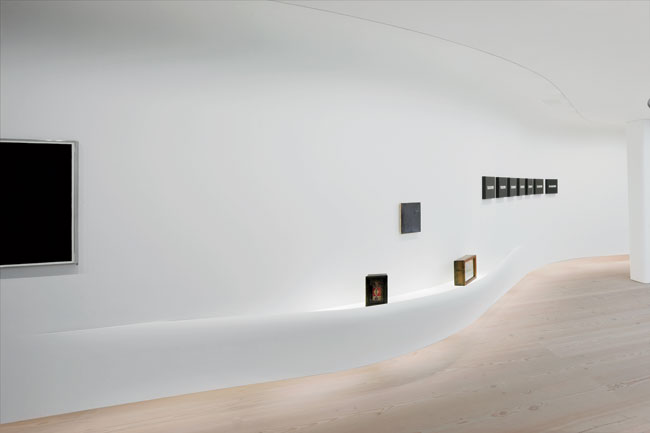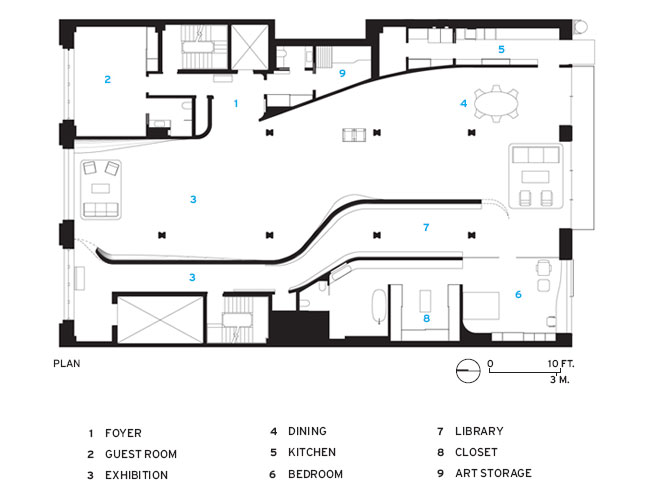Greenwich Village, New York City, United States
UNStudio
Post By:Kitticoon Poopong
 |
| Photo © Courtesy of Iwan Baan |
en van
Berkel, principal of the Amsterdam-based architectural firm UNStudio, is known for his breathtakingly swoopy designs of sleek surfaces that never seem to end. The gleaming, aluminum-clad
Mercedes-Benz Museum in
Stuttgart, Germany, with its double-spiral-ramped concrete structure
 |
| Photo © Courtesy of Iwan Baan |
fter completing that nine-story-high, 270,000 square-foot building, you might think that a 5,840-square-foot (gross) residential loft would be too rinky-dink a commission. Van Berkel argues otherwise: “I’m not interested as much in the scale of a project as with the program,” he explains. In this case, he was asked to design a loft in New York City for a collector of Modern and contemporary art, which he found fascinating. “It’s as if you’re making a portrait of someone and how he might live with his art,” van Berkel adds.
 |
| Photo © Courtesy of Iwan Baan |
he owner met the architect when van Berkel was working on an ill-fated expansion of the
Wadsworth Atheneum in Hartford, Connecticut, earlier in the decade. The collector, who had seen UNStudio’s famous Möbius House (1998) in
Het Gooi, the Netherlands, says, “I found a clarity in the language and a logic of the space that made me think about the way I lived.” He decided to seek van Berkel’s help “in making sense out of the muddle that had become my art collection.”
 |
| Photo © Courtesy of Iwan Baan |
he architect’s solution for the apartment, on a floor 95 feet long and almost 60 feet wide in a former light-industrial building, was as logical as it was novel: He pushed living spaces along the east and west party walls, saving the central portion for the gallery. At the north and south ends, the architect clustered living and dining areas, inserting a steel-and-glass wall on the south elevation, where a glass balcony allows unobstructed garden views.
 |
| Photo © Courtesy of Iwan Baan |
he design team — including van Berkel; the executive architect Franke, Gottsegen, Cox Architects; and lighting designer Richard Renfro — created a swerving hung ceiling where arrays of 18,000 individual
LEDs could be mounted above two layers of a translucent, two-way-stretched polymer membrane. Tracks separating the fabric ceiling from the plaster surfaces accommodate fixtures for point lighting. “The ceiling took nearly a year to test and rework,” recalls the client.
 |
| Photo © Courtesy of Iwan Baan |
The team programmed the lighting to offer a changing mix of cool and warm illumination. A combination of fluorescent (on the underside of the major gallery wall) and halogen fixtures (embedded in the coves along with HVAC diffusers) provide additional indirect light.
 |
| Photo © Courtesy of Iwan Baan |
hile the actual structure of the early-20th-century building is concrete deck, and the steel columns are covered with terra-cotta fireproofing, very little of this structure is revealed by the continuous, off-white surfaces. Van Berkel covered the columns with preformed glass-fiber-reinforced-gypsum shapes, which were then hand-plastered on-site. He used these preformed elements for the concave ceiling coves and other curved pieces as well, including ones extending from the wall to the floor.
 |
| Photo © Courtesy of Iwan Baan |
Hand-plastered surfaces characterize all walls — formed of metal stud and cement board — as well as much of the ceiling. The wall on the west side of the gallery, dividing the art display from the library, is a formal tour de force, seeming to float as it carries artworks on one side and the collection of books on the other. As Matthew Gottsegen of Franke, Gottsegen, Cox Architects explains, it is suspended from a steel beam in the existing building; the wall touches down on the north end to stabilize its curves.
 |
| Photo © Courtesy of Iwan Baan |
The library’s narrow, serpentine space allows the client to easily see his books, without having to rely on a typical four-walled room plan where a desk is plunked down in themiddle.He avows, “The library turned out to be the most captivating part of thedesign.”
This softly radiant setting, where off-white is the predominant color, allows the selected sculptures, paintings, drawings, and rare books to be seen as objects in space. Even Leo, the owner’s bulldog, matches the color scheme. As the client puts it, “While it was a long time in the making, it far exceeds my hopes. The architecture still awes me, yet envelops me in a comforting way. Would I do it again? Never.” But then, why should he?
 |
| diagram--drawing Courtesy of UNStudio |
 |
| floor plan--drawing Courtesy of UNStudio |
The people
Interior Designer: UNStudio
Location: Greenwich Village, New York City, United States
Design Year: 2007-2009
Construction Year: 2008-2009
Completion/Opening Date: 2010
Gross Square Footage: 5,840 sq.ft.
Photographs: Iwan Baan
Design Architect:
UNStudio
Stadhouderskade 113
PO Box 75381
1070AJ Amsterdam
via:archrecord
« Return to article
People Design Architect:
UNStudio
Stadhouderskade 113
PO Box 75381
1070AJ Amsterdam
Project team: Ben van Berkel with Arjan Dingsté, Marianthi Tatari and Colette Parras
Local Executive Architect:
Franke, Gottsegen, Cox Architects
78 Union Street
Brooklyn, NY 11231
Project team: Matthew Gottsegen, Bruce Harvey, Matt Shoor
Construction Management:
3-D Laboratory Inc.
268 Water Street,
NY, NY 10038
Consultants:
Lighting Designer:
Renfro Design Group, Inc.
15 East 32nd Street
New York, NY 10016
Project team: Richard Renfro, Sarah Randall
MEP Engineer
PA Collins, PE
1140 Broadway
Suite 203
New York, NY 10001
Structural Engineer
Wayman C. Wing Consulting Engineers
15 Penn Plaza
New York, NY 10001
Acoustical Consultant:
Acoustilog, Inc.
19 Mercer Street
New York, NY 10013
Photographer: Iwan Baan | | ProductsBuilding Information
Site Dimensions: 29,0 m x 18,2 m (95’3” x 59’8”)
Building Height: interior project
Number of Floors Below Grade: interior project
Number of Floors Above Grade: interior project
Floor Area:
Gross: 543 m2 (5841 ft2)
Net: 439 m2 (4726 ft2)
Volume: 1185 m3
Residential: 439 m2
Individual spaces:
Exhibition Area: 239 m2 (2568 ft2)
Library Area: 49 m2 (525 ft2)
Exterior Materials
Substructure: existing
Superstructure: existing
Envelope: Aluminum panels at South façade.
Interior Materials / suppliers
Flooring:
Douglas Fir, 45cm wide x 7m long, Dinesen
Terra XXL, Royal Mosa
Glazing:
South Façade, Skyframe
North Façade, Panorama Windows Ltd.
Ceilings:
Glass Fiber Reinforced Gypsum (G.R.G.), Formglas
Stretch ceiling translucent membrane, Newmat
Aluminum extruded ceiling tracks, Newmat
Wall finishes:
Glassfiber Reinforced Gypsum (G.R.G.), Formglas
Gypsum Board
Back painted glass panels in master bathroom
Royal Mosa, Terra XXL
Lighting: LED, GE Lumination
Furnishings: (type and manufacturer)
Kitchen appliances:
Gaggenau
All bathroom fixtures & accessories: Vola Bathtub, Agape – Deep Bathroom sinks, Marike Toilets & Bidet, Duravit – Starck 2
Fixtures and fittings:
Door hardware: d line
Invisible door hinges: Soss
Pocket door hardware: Accurate
Special elements:
Total home automation system: Crestron
Custom-made furniture: Douglas Fir wood & Corian
|












